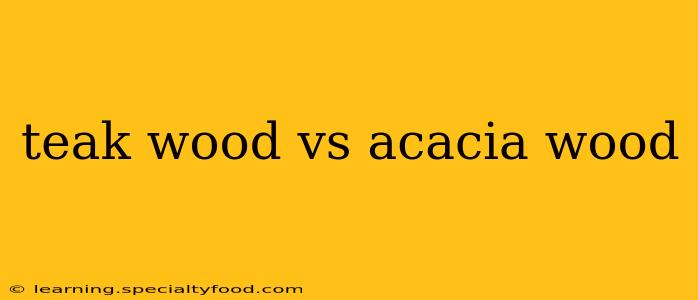Choosing the right wood for your furniture, decking, or other projects can be a daunting task. Two popular choices often top the list: teak and acacia. Both are known for their durability and attractive aesthetics, but they possess distinct characteristics that make them better suited for different applications. This comprehensive guide will delve into the key differences between teak wood and acacia wood, helping you make an informed decision.
What is Teak Wood?
Teak ( Tectona grandis) is a tropical hardwood renowned for its exceptional durability, water resistance, and rich golden-brown color. Native to Southeast Asia, it's prized for its natural oils and high density, which provide excellent protection against rot, decay, and insect infestation. This makes it a popular choice for outdoor furniture, boat decks, and other applications exposed to the elements. Over time, teak weathers to a beautiful silvery-gray patina, adding to its unique charm.
What is Acacia Wood?
Acacia (Acacia spp.) encompasses a wide range of hardwood species, many of which are fast-growing and sustainably sourced. While not as naturally resistant to decay as teak, acacia is still relatively durable and offers a beautiful range of colors, from light golden browns to rich reddish hues. Its density and hardness vary depending on the specific acacia species, but generally, it's a more affordable option compared to teak.
Teak Wood vs. Acacia Wood: Key Differences
Here's a detailed comparison highlighting the key differences between teak and acacia wood:
Durability and Weather Resistance:
- Teak: Superior durability and weather resistance due to its high natural oil content. It's exceptionally resistant to rot, decay, and insect infestation, requiring minimal maintenance even in harsh outdoor conditions.
- Acacia: Moderately durable and weather-resistant, but not as resistant to decay as teak. It may require more regular maintenance, such as oiling or sealing, especially in areas with high humidity or rainfall.
Cost:
- Teak: Generally more expensive than acacia due to its slower growth rate, limited supply, and superior properties.
- Acacia: More affordable and readily available, making it a budget-friendly option for many projects.
Appearance and Color:
- Teak: Rich golden-brown color that weathers to a silvery-gray patina over time. The grain is typically straight and even.
- Acacia: Wide range of colors, from light golden browns to deep reddish hues. The grain can vary depending on the species, with some exhibiting more pronounced grain patterns than others.
Maintenance:
- Teak: Requires minimal maintenance, often only requiring occasional cleaning. While it can be oiled to maintain its original color, it naturally weathers beautifully.
- Acacia: May require more regular maintenance, including oiling or sealing, to protect it from the elements and prevent decay.
Sustainability:
- Teak: Sustainable teak sources are crucial. Look for certifications like the Forest Stewardship Council (FSC) to ensure responsible sourcing. Unsustainable harvesting has threatened teak forests in the past.
- Acacia: Many acacia species are fast-growing and can be sustainably harvested, making it a more environmentally friendly option in many cases. Again, certifications are vital to verify sustainable practices.
Which Wood is Right for You?
The best choice between teak and acacia depends on your specific needs and budget.
- Choose teak if: You need superior durability and weather resistance for outdoor applications, are willing to pay a premium for exceptional quality, and prioritize longevity. The natural weathering process also appeals to many.
- Choose acacia if: You're working on a budget, need a durable wood for indoor or less exposed outdoor projects, and appreciate a wide range of color options. Remember that regular maintenance will be necessary to ensure its longevity.
Frequently Asked Questions (FAQ)
Is acacia wood as strong as teak?
Acacia wood is strong, but not as strong as teak. Teak's higher density and oil content contribute to its superior strength and durability.
Is acacia wood waterproof?
Acacia wood is not waterproof, but it is more water-resistant than many other softwoods. However, proper sealing is recommended for applications exposed to significant moisture.
Does acacia wood rot easily?
Acacia wood is less resistant to rot and decay than teak. Proper sealing and maintenance are crucial to prevent rot in wet or humid conditions.
Which is better for outdoor furniture: teak or acacia?
Teak is generally better for outdoor furniture due to its superior weather resistance and durability. However, properly treated and maintained acacia can also be suitable for some outdoor applications.
What is the lifespan of teak and acacia wood?
With proper care, teak can last for decades, even centuries in some cases. Acacia's lifespan is shorter, but still considerable, provided it's adequately maintained.
By understanding the distinct properties of teak and acacia wood, you can select the ideal material for your project, ensuring both aesthetic appeal and lasting durability. Remember to always prioritize sustainably sourced wood to support responsible forestry practices.
